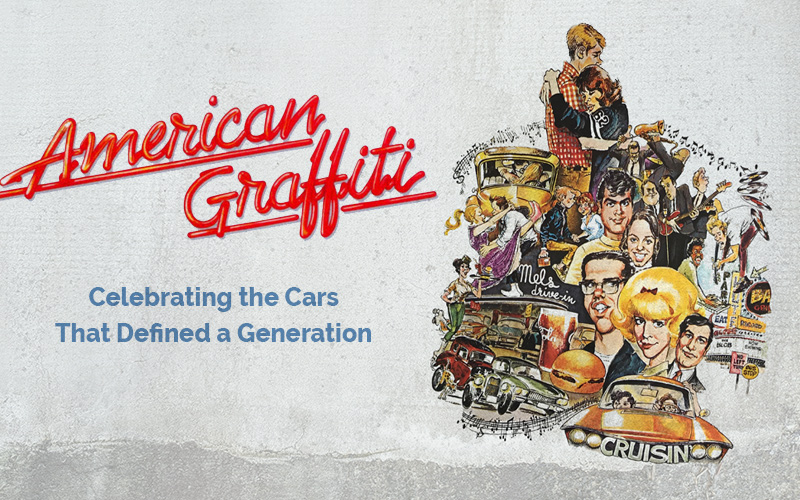
Released in 1973, “American Graffiti” is a coming-of-age classic directed by George Lucas that captured the essence of cruising culture in the early 1960s. Set in Modesto, California, the film takes place on a single night, following a group of high school graduates as they navigate the uncertainty of their futures before going off to college or entering the workforce. Amidst the compelling characters and reminiscent soundtrack, one of the key elements that made “American Graffiti” resonate with audiences was the iconic lineup of cars that served as extensions of the characters’ personalities and symbolized the vibrant car culture of the time.

Classic Cars as Characters
In “American Graffiti,” the cars themselves are treated as characters with distinct personalities, reflecting the tastes and aspirations of their owners. The movie prominently features several cars, each bearing unique traits that define their drivers.
Capturing the essence of the early 1960s car culture in “American Graffiti” required careful attention to detail and authenticity. To ensure the cars looked and felt authentic, the filmmakers enlisted the help of local car clubs and enthusiasts.
The film’s production team scoured California to find the perfect classic cars that represented the time accurately. They approached car owners and car clubs, seeking their participation in the film. As a result, many of the cars featured in the movie were authentic classics that had been lovingly restored and maintained by dedicated enthusiasts. Local car clubs also played an instrumental role in ensuring the accuracy of the movie’s car scenes. The clubs provided technical advice, lent their cars for filming, and even helped with road closures for crucial scenes. This collaboration with car clubs added an extra layer of authenticity to the film, making the cars and the car culture they represented come alive on the big screen.
The Supporting Cast
1932 Ford 5-Window Coupe
One of the most iconic cars in the film is the 1932 Ford Coupe driven by John Milner, portrayed by Paul Le Mat. This bright yellow “Deuce Coupe” embodies Milner’s rebellious spirit and love for speed. As the self-proclaimed “King of the Strip,” Milner is a seasoned street racer who takes pride in his hot rod, spending countless hours tuning and customizing it. The classic ’32 Ford body, complete with a rumble seat, speaks to the film’s nostalgia for the early days of hot-rodding.
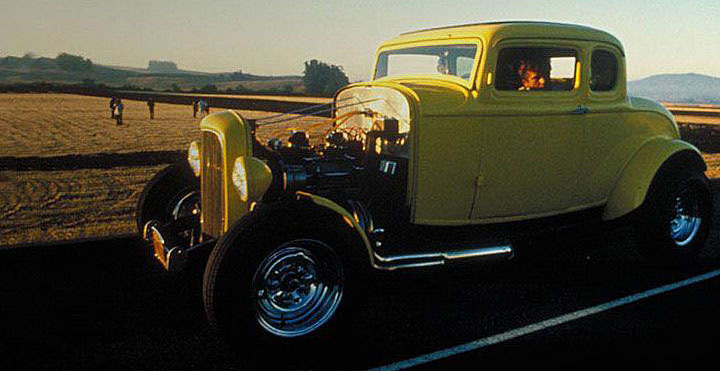
1955 Chevrolet 150

Harrison Ford takes on the role of Bob Falfa, an overconfident out-of-town challenger, driving a menacing black 1955 Chevrolet 150. Exuding an air of arrogance and boldness, Falfa arrives in town with the sole purpose of proving his Chevy’s speed and dominance. His sleek black Chevy 150, enhanced with a hood scoop and a rollcage, maintains an intimidating presence that perfectly complements his personality, creating an imposing and formidable combination.
1951 Mercury Coupe

Curt Henderson, played by Richard Dreyfuss, cruises through the night as a passenger in a modified 1951 Mercury. The 1949-51 Mercurys earned their reputation as the ultimate custom cars, capturing the hearts of “lead sled” enthusiasts who sought to personalize them. These vehicles quickly surged in popularity as customizers lowered them, eliminated the stock trim, and executed custom bodywork, most notably, chopping the top. These alterations worked magic, turning the once modest Mercuries into elegant and menacing cruisers. However, it’s crucial to note that these “leadsled” customs primarily emphasized style rather than high-performance capabilities.
1956 Ford Thunderbird
Suzanne Somers plays the role of Laurie Henderson, Curt’s love interest, who drives a striking 1956 Ford Thunderbird. This sleek convertible reflects Laurie’s beauty and elegance, setting her apart from the rowdy car scene. The Thunderbird was Ford’s response to the Chevrolet Corvette, offering a blend of style and performance, making it the perfect choice for a character like Laurie. The 1956 Ford Thunderbird was offered with 292ci Y-block V8 or the new 312 Y-block V8 and a 4 barrel Holley carburetor that produced 215 HP.

1958 Edsel Corsair
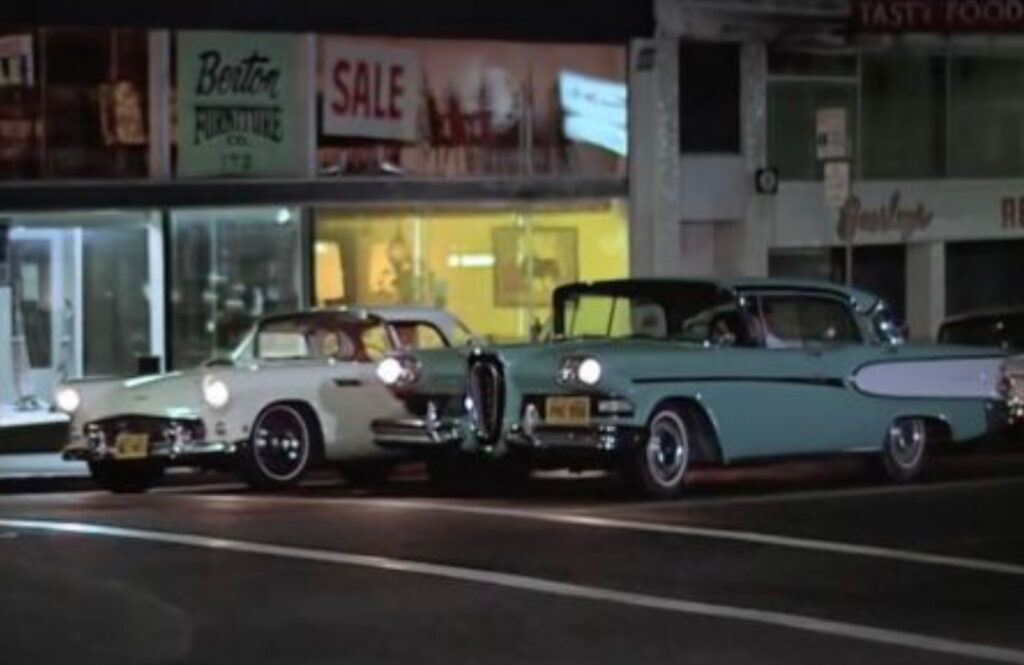
Lorie, Curt’s sister and Steve’s girlfriend, takes the wheel of an Edsel in contrast to her brother’s Citroën. While Curt’s car may have been a bit modest, Lorie’s Edsel was considered a fine choice for a teenager during that era. However, the Edsel didn’t fare well in the market and is now infamous as one of Ford Motor Company’s most significant automotive failures.
1958 Chevrolet Bel Air Impala
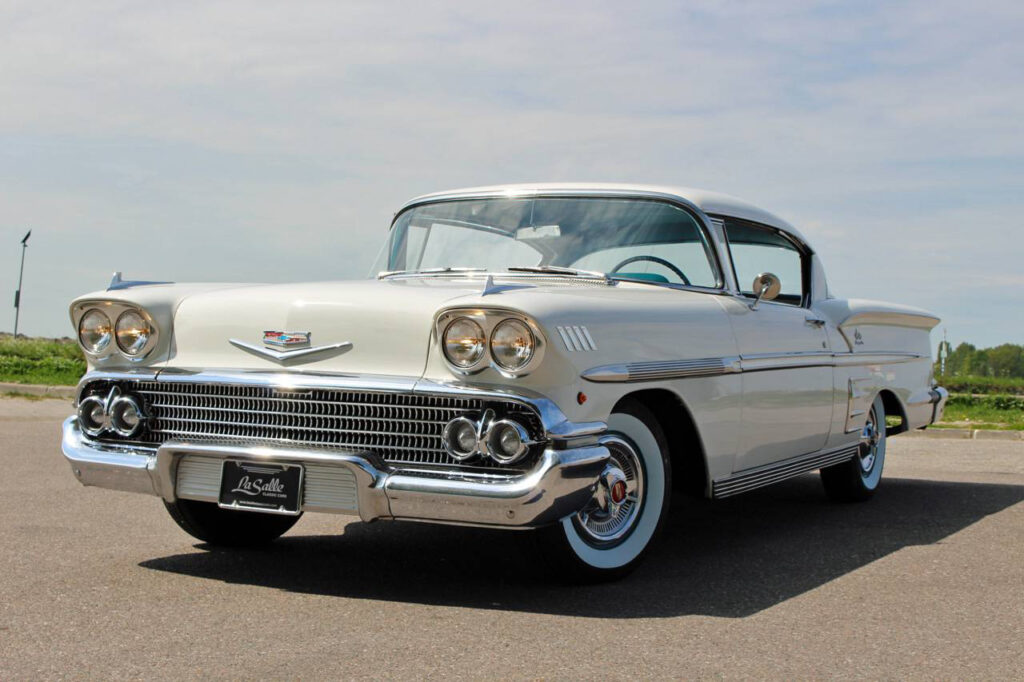
Ron Howard’s character, Steve Bolander, rolls through the night in his 1958 Chevrolet Bel Air Impala, a modified hot rod with a powerful engine and eye-catching flames painted along the sides. The car represents Steve’s desire to break free from the conventions of his small-town life and embrace the excitement and adventure of the world beyond Modesto.
The Car Culture of the Early 1960s
“American Graffiti” provides a captivating snapshot of the car culture that thrived in the early 1960s, characterized by drag racing, cruising, and camaraderie among car enthusiasts. This period was marked by a strong fascination with automobiles, where young people found liberation, expression, and a sense of belonging through their cars.

The movie’s backdrop is the “strip,” a stretch of road where local youths gathered to show off their cars and engage in drag races. Drag racing was a defining element of the car culture at the time, serving as a competitive outlet for young drivers seeking to prove the prowess of their vehicles. The “strip” was not just a physical location but a symbol of freedom and community for the characters in the film.
Cruising was a central aspect of the car culture depicted in the film. Young people would drive up and down the main streets of their towns, socializing with friends and potential romantic partners, and enjoying the sense of freedom that came with being behind the wheel. The film’s characters find a sense of belonging as they cruise the streets of Modesto, bonding over their shared love for cars and music.

“American Graffiti” showcases the art of hot rodding, a popular practice in the ’60s where car enthusiasts modified their vehicles to enhance performance and aesthetics. This trend stemmed from the post-World War II surplus of military aircraft parts, which were repurposed to create high-performance engines. The film’s emphasis on customized cars reflects the ingenuity and passion of the era’s car enthusiasts.
Legacy and Influence
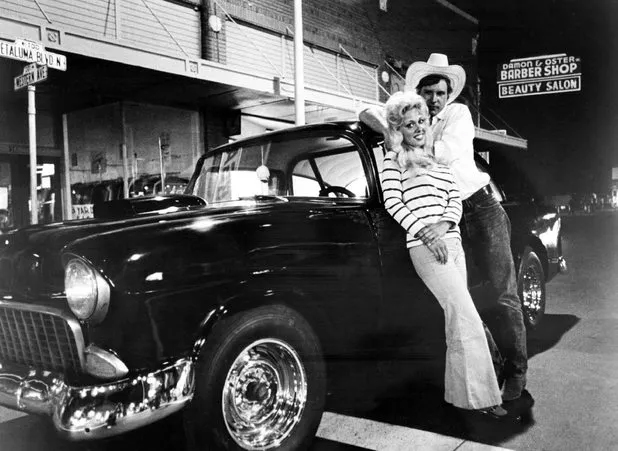
Over the years, “American Graffiti” has become an enduring classic that continues to resonate with audiences worldwide. The film’s portrayal of cars and the car culture of the early 1960s has left an indelible mark on popular culture, influencing subsequent films, TV shows, and even inspiring a revival of interest in vintage cars.
“American Graffiti” paved the way for a sub-genre of coming-of-age films centered around classic cars and car community. It inspired movies like “Dazed and Confused” and “The Fast and the Furious” series, all of which draw inspiration from the themes of friendship, freedom, and self-discovery that made “American Graffiti” such a beloved film.
The movie’s impact also extends to the real-world car enthusiast community. Car shows and festivals dedicated to showcasing classic cars from the 1950s and 1960s have grown in popularity, attracting enthusiasts from all walks of life. The film’s iconic cars are often featured as centerpieces in such events, keeping the spirit of “American Graffiti” alive in the present day.
“American Graffiti” remains a timeless celebration of adolescence, friendship, and the profound connection between young people and their cars. Through its characters and the vehicles they drive, the film captures the spirit of an era defined by a passion for automobiles and the desire for adventure. As a cinematic masterpiece, it not only reflects the past but continues to influence and inspire car enthusiasts and filmmakers alike. The cars in “American Graffiti” serve as rolling symbols of the vibrant and transformative car culture of the early 1960s, ensuring their place in cinematic history for generations to come.


